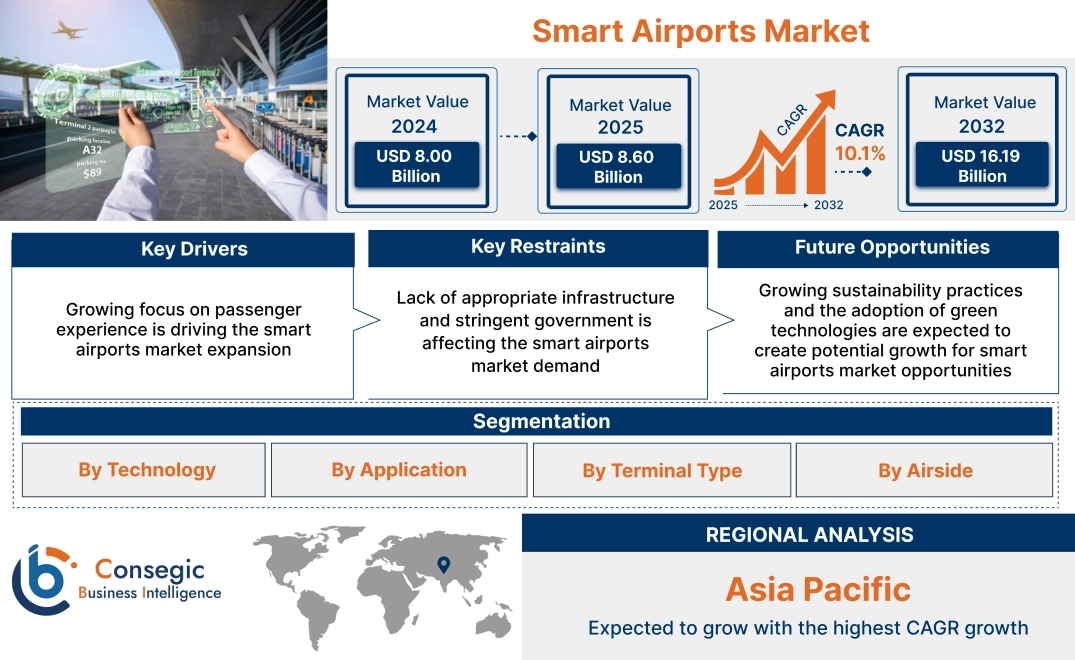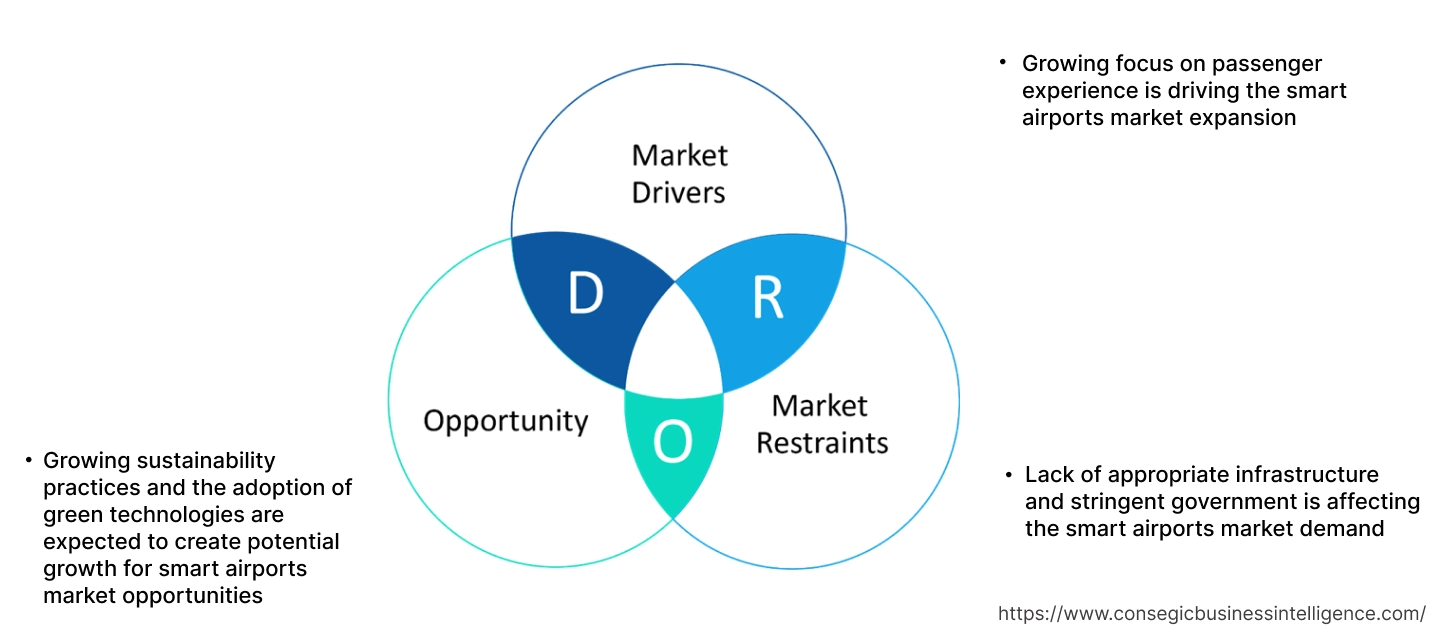Smart Airports Market Size:
Smart Airports Market Size is estimated to reach over USD 16.19 Billion by 2032 from a value of USD 8.00 Billion in 2024 and is projected to grow by USD 8.60 Billion in 2025, growing at a CAGR of 10.1% from 2025 to 2032.
Smart Airports Market Scope & Overview:
Smart airports leverage cutting-edge technologies to optimize operations, enhance security, and improve the overall passenger journey from check-in to boarding. The airports around the world are struggling with increasing passenger volumes, stringent security requirements, and the need for sustainable practices. To overcome these challenges, airports are embracing digital transformation and investing in smart infrastructure and solutions. Further, airports can adapt to evolving passenger needs, improve safety and security measures, and create sustainable environments that foster innovation and collaboration across the aviation ecosystem.
How is AI Transforming the Smart Airports Market?
The integration of AI is significantly transforming the smart airport sector, specifically by improving operations and passenger experiences by optimizing passenger flow, enhancing security with automated threat detection and facial recognition, managing baggage handling with robots, and providing personalized customer service through chatbots and virtual assistants. Moreover, AI integration also enables predictive maintenance for equipment and infrastructure, optimizes air traffic control, and helps manage resources more efficiently through real-time data analytics. Further, AI-powered tools provide constant 24/7, multi-lingual support, answering queries related to flight status and airport services, thereby improving passenger experiences within airports. Therefore, the aforementioned factors are expected to drive the market growth in upcoming years.
Key Drivers:
Growing focus on passenger experience is driving the smart airports market expansion
The growing focus on enhancing passenger experience and satisfaction has become a driving force behind airports' investments in smart technologies. By leveraging technologies such as biometrics, self-service kiosks, and mobile apps, airports offer seamless and efficient check-in experiences, while reducing waiting times. Furthermore, smart airports are increasingly incorporating entertainment and retail options into their facilities to enhance the passenger experience. By integrating digital signage, interactive displays, and immersive experiences, airports can transform the terminal environment into a better and engaging space that offers entertainment, relaxation, and retail therapy to travelers.
- For instance, in November 2023, Honululu airport introduced SITA Smart path for biometric-enabled exit to support U.S. customs, while fulfilling the biometric screening for passengers on the exit. This technology will offer travelers a touchless process that will streamline international departures.
Thus, according to the smart airports market analysis, the growing focus on passenger experience is driving the smart airports market size.
Key Restraints:
Lack of appropriate infrastructure and stringent government is affecting the smart airports market demand
Despite the growing aerospace sector and ongoing renovations at older airports, certain regions face challenges with inadequate infrastructure to accommodate modern aircraft and deliver essential services. The role of government entities, particularly civil aviation ministries, is crucial in managing airport-related services and infrastructure development. Additionally, airports worldwide function under various governance systems, each customized to meet local needs and priorities. This diversity in governance structures of airports depicts the sector’s complexity and the necessity for collaboration among market players to navigate the current scenario and foster the recovery of the aviation sector. The above-mentioned factors are hampering the smart airports market size.
Future Opportunities :
Growing sustainability practices and the adoption of green technologies are expected to create potential growth for smart airports market opportunities
Sustainability has become a crucial parameter in airport operations. Airport operators leverage this trend by investing in renewable energy sources, such as solar panels and wind turbines, to power airport facilities, thereby decreasing dependence on fossil fuels and lowering greenhouse gas emissions. Furthermore, the adoption of energy-efficient lighting, heating, ventilation, and air conditioning (HVAC) systems can significantly enhance sustainability efforts. By adopting sustainable practices and green technologies, airport service providers can stay ahead in the competitive market, attract eco-aware passengers, and contribute to the broader objectives of environmental conservation and climate action.
- For instance, in December 2022, Mumbai International Airport fully transitioned to green energy sources for its consumption, establishing itself as a sustainable airport of India. CSMIA was the first airport in India to implement hybrid technology powered exclusively by green energy since April 2022, promoting a highly efficient and low-carbon future for aviation. This sustainable initiative is part of airport’s goal to achieve Net Zero emissions.
Thus, based on the analysis, the rising adoption of green technologies at international and domestic airports are driving smart airports market opportunities.
Smart Airports Market Segmental Analysis :
By Technology:
Based on technology, the smart airports market is segmented into security systems, communication systems, cargo & baggage handling control, air/ground traffic control, endpoint devices, and others.
Trends in technology:
- Smart airports are advancing quickly, using advanced technologies to make travel experience better for passengers and more efficient for operators. AR and VR technologies are becoming an ideal choice, while making airports more engaging.
- 5G networks are progressing communication networks, while helping airports monitor security in real-time and improving-in-flight services.
The cargo & baggage handling control segment accounted for the largest revenue share in the year 2024.
- Airports worldwide are investing heavily in upgrading their baggage handling infrastructure to accommodate larger aircraft, increase throughput capacity, and minimize delays and mishandled baggage incidents.
- By investing in technologies like advanced baggage screening systems and automated tracking solutions, airports enhance their security measures while optimizing operational efficiency.
- For instance, in September 2023, Vaderlande announced the partnership with Avinor, to provide complete automation in baggage handling at the airports. Through this collaboration, Vanderlande offered two solutions, BagLoad for integrated robot loading and Fleet Batch for ULD transportation to elevate the efficiency and dependability of cargo and baggage handling processes.
- Thus, as per analysis, the aforementioned factors are driving the smart airports market growth.
The security systems segment is anticipated to register the fastest CAGR during the forecast period.
- The increasing need for air travel and the rising threat of cyber-attacks on airports are expected to drive the segment progression.
- The rise of tourism and the growing trend of experiential travel is expected to increase in air travel requirement.
- The growing integration of biometrics in various security applications presents significant prospects for enhancing safety and convenience. Biometrics, such as fingerprint recognition, facial recognition, and iris scans, offer a level of accuracy, that traditional security methods, like passwords or PINs, cannot match.
- These factors will be driving the smart airports market demand during the forecast period.
By Application:
Based on application, the market is segmented into aeronautical operations and non-aeronautical operations.
Trends in Application:
- Business applications encompass revenue-generating services such as retail, hospitality, and advertising, which capitalize on smart technologies to enhance the passenger experience and generate additional sources of income for airports.
- Governments and private organizations are aggressively investing in airport infrastructure worldwide. This encompasses opening out of existing terminals, new airport construction, and upgrades to facilities.
The aeronautical services segment accounted for the largest revenue share in the year 2024.
- Aircraft ground handling services are crucial component of aeronautical applications, comprises of various tasks such as lavatory cleaning, ramp operations parking assistance, and others. These services are essential for ensuring efficient turnaround times for aircraft between flights and for smooth functioning of airports.
- Aircraft maintenance services play a pivotal role within the aeronautical segment, encompassing a range of activities aimed at ensuring the airworthiness of aircraft. This includes routine inspections, periodic repairs, and other maintenance tasks essential for the continued safe operation of aircraft.
- These developments are collectively driving the smart airports market trends.
The non-aeronautical operations segment is anticipated to register the fastest CAGR during the forecast period.
- The evolution of consumer behaviour and preferences is playing a vital role in driving the non-aeronautical revenue applications. Consequently, airports are diversifying their amenities to include high-quality retail outlets, parking services, dining establishments, and entertainment options within terminal facilities, catering to the evolving needs and desires of passengers during their wait times.
- The proliferation of e-commerce has given rise to airports to embrace digital transformation initiatives, facilitating the development of online shopping platforms and contactless payment solutions. These technological advancements not only streamline the shopping experience for passengers but also contribute to the non-aeronautical applications.
- For instance, in August 2024, The Veer Savarkar International Airport, Port Blair, India launched an automated parking system featuring an automatic ticket dispenser, a CCTV, and sensor-based boom barrier, to provide a seamless parking experience for passengers and visitors.
- These factors are driving the need for smart airports during the forecast period.
By Terminal Type:
Based on terminal type, the market is segmented into baggage handling, check-in systems, building operations, and sustainable energy management.
Trends in Terminal Type:
- The segment growth can be attributed to the rising need for air travel, technological advancements, increased investments in airport infrastructure, and the necessity to streamline operations to improve passenger experience and optimize airport efficiency.
- A major trend influencing the terminal type segment is the widespread adoption of advanced technologies to automate and enhance various processes. This encompasses the deployment of self-service kiosks for check-in, biometric authentication systems for security screening, and baggage handling systems incorporating RFID technology for improved tracking and efficiency.
The baggage handling segment accounted for the largest revenue share of 33.53% in the year 2024 and it is expected to register the highest CAGR during the forecast period.
- The stringent regulations and security protocols mandated by aviation authorities demand sophisticated baggage handling that prioritize compliance and safety.
- By investing in technologies like advanced baggage screening systems and automated tracking solutions, airports enhance their security measures while optimizing operational efficiency.
- The ongoing modernization efforts at new and existing airports worldwide contribute significantly to the segment expansion, as airports are adapting cutting-edge technologies to streamline operations and enhance passenger experience.
- These factors are driving the smart airports market trends.
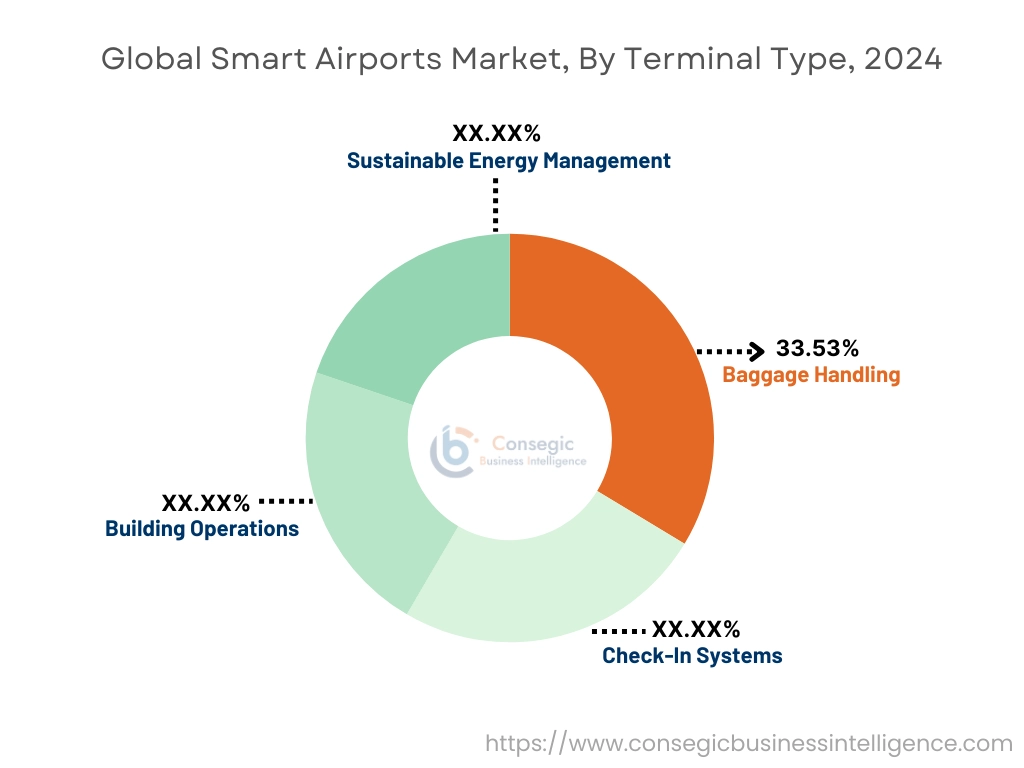
By Airside:
Based on airside, the market is segmented into ATM, resource management, aircraft parking, and aircraft maintenance.
Trends in Airside:
- The seamless integration with landside and terminal side operations through technologies, such as digital passenger flow management systems, improves airport efficiency, and passenger experience.
- The surge in need for airside services is fuelled by the increasing trend of international travel and tourism. With globalization and improved connectivity, there is a growing preference for international travel among individuals worldwide.
The aircraft maintenance segment accounted for the largest revenue in the year 2024 and it is expected to register the highest CAGR during the forecast period.
- The aircraft line maintenance segment has experienced significant growth due to the increasing demand for air travel, resulting in a higher number of flights and aircrafts in operation. Airlines and aircraft operators rely on line maintenance providers to minimize aircraft downtime, ensure on-time departures, and optimize fleet performance.
- Moreover, the rise of low-cost carriers and the development of airline networks are fuelling the demand for line maintenance services.
- The growing emphasis on sustainability is driving the development of eco-friendly maintenance practices, such as the use of biofuels and environmentally friendly materials in the maintenance processes.
- These factors are expected to drive the smart airports market growth during the forecast period.
Regional Analysis:
The regions covered are North America, Europe, Asia Pacific, the Middle East and Africa, and Latin America.
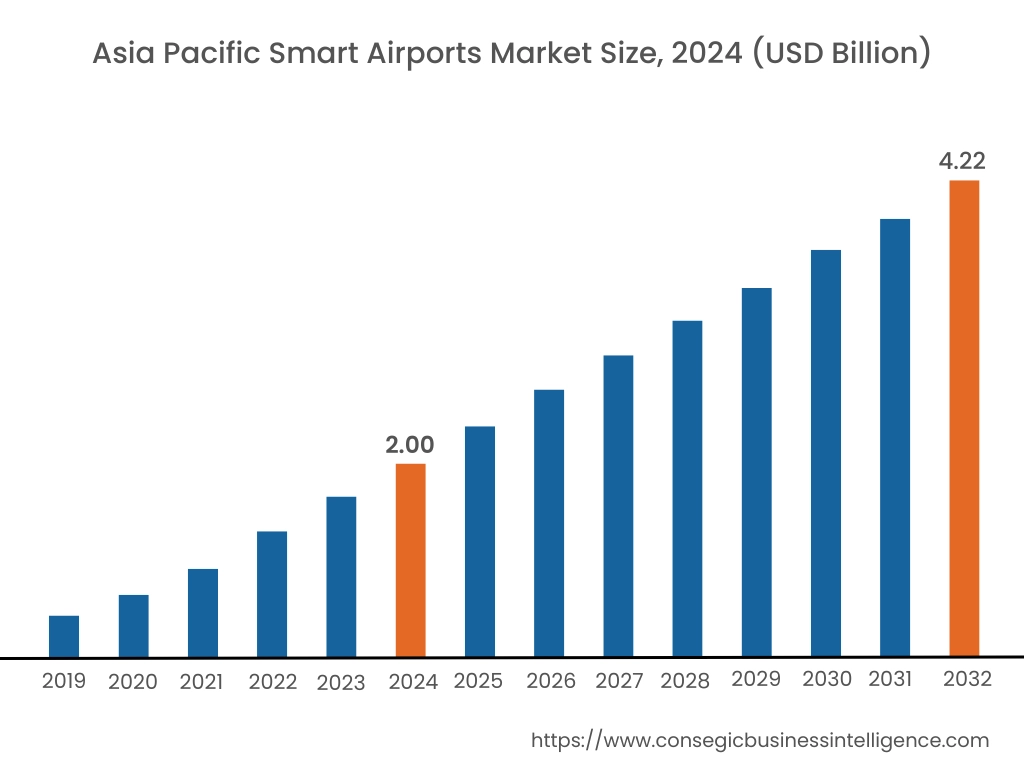
Asia Pacific smart airports market expansion is estimated to reach over USD 4.22 billion by 2032 from a value of USD 2.00 billion in 2024 and is projected to grow by USD 2.15 billion in 2025. Out of this, the China market accounted for the maximum revenue split of 32.6%. The Asia Pacific presents significant share in the regional market, driven by rapid urbanization, increasing air travel demand, and government initiatives aiming at modernizing airport infrastructure across the region. Countries such as China, India, and Southeast Asian nations are witnessing robust progression in air passenger traffic, prompting airports to invest in smart technologies to enhance operational efficiency and passenger experience. These trends would further drive the regional smart airports market share during the forecast period.
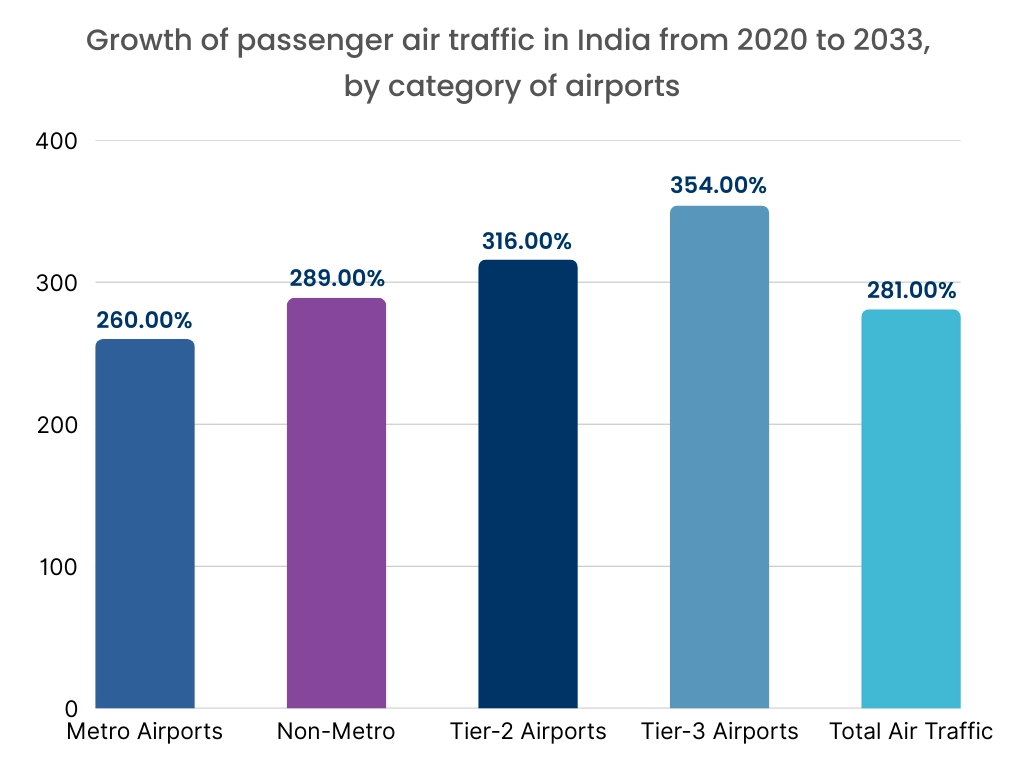
- For instance, in October 2024, Adani Airport Holdings Limited announced the partnership with Thales to improve passenger experiences and airport operations across India. With this strategic partnership, Thales will deploy Fly to Gate biometric system, utilizing facial recognition to speed up passenger processing upto 30%.
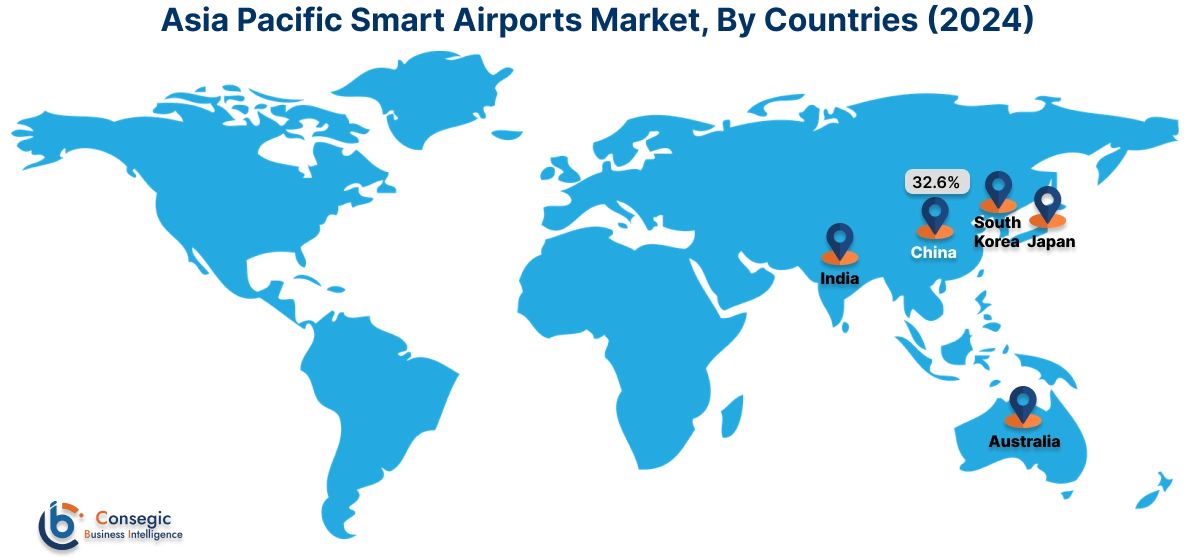
North America market is estimated to reach over USD 5.64 billion by 2032 from a value of USD 2.81 billion in 2024 and is projected to grow by USD 3.02 billion in 2025. North America's airport infrastructure is experiencing substantial progress and development to meet the region's increasing air travel requirements and economic vitality. Key airports of the country, such as Los Angeles International Airport and Hartsfield-Jackson Atlanta International Airport are going through development projects to handle heightened passenger traffic. Further, sustainability initiatives, emphasizing eco-friendly designs, energy-efficient facilities, and minimized environmental impact, are increasingly incorporated into extension plans. These factors further contribute to the region’s leading position in the smart airports market share.
- For instance, in January 2023, Hobby Airport in Houston announced the launch of 10 new restaurants within the airport. This initiative is projected to generate approximately USD 74 million in revenue and create at least 300 jobs.
According to the smart airports industry analysis, the European market has experienced significant development in recent years. European airports are actively included in carbon offset initiatives and developments, and the region has the highest concentration of airports that have successfully obtained Airport Carbon Accreditation. Additionally, airports in Latin America are consistently upgrading customer service and facilities. The high passenger demand, stable GDP growth, and low commodity prices are also key factors that drive the regional market. Furthermore, in the Middle East, governments and airport authorities are investing in initiatives to modernize airport facilities, improve connectivity, and implement smart technologies. Thus, on the above smart airports market analysis, the aforementioned factors further drive the regional market during the forecast period.
Top Key Players and Market Share Insights:
The global smart airports market is highly competitive with major players providing airport solutions to the national and international markets. Key players are adopting several strategies in research and development (R&D), product innovation, and end-user launches to hold a strong position in the market. Key players in the smart airports industry include-
- SITA (Switzerland)
- Huawei Technologies Co., LTD. (China)
- Smart Airport Systems (SAS) (France)
- Infax, Inc. (U.S.)
- IBM Corporation (U.S.)
- Honeywell International Inc. (U.S.)
- Thales Group (France)
- Daifuku Co., LTD. (Japan)
- Siemens AG (Germany)
- Amadeus IT Group SA (Spain)
Recent Industry Developments :
Product Development:
- In April 2024, Honeywell introduced Surface Alert (SURF-A), a software technology that will support in runway intrusion avoidance. The technology alerts the pilots by presenting audio and visual data for potential conflicts on the runway.
Smart Airports Market Report Insights:
| Report Attributes | Report Details |
| Study Timeline | 2019-2032 |
| Market Size in 2032 | USD 16.19 Billion |
| CAGR (2025-2032) | 10.1% |
| By Technology |
|
| By Application |
|
| By Terminal Type |
|
| By Airside |
|
| By Region |
|
| Key Players |
|
| North America | U.S. Canada Mexico |
| Europe | U.K. Germany France Spain Italy Russia Benelux Rest of Europe |
| APAC | China South Korea Japan India Australia ASEAN Rest of Asia-Pacific |
| Middle East and Africa | GCC Turkey South Africa Rest of MEA |
| LATAM | Brazil Argentina Chile Rest of LATAM |
| Report Coverage |
|
Key Questions Answered in the Report
How big is the Smart Airports market? +
Smart Airports Market Size is estimated to reach over USD 16.19 Billion by 2032 from a value of USD 8.00 Billion in 2024 and is projected to grow by USD 8.60 Billion in 2025, growing at a CAGR of 10.1% from 2025 to 2032.
Which is the fastest-growing region in the Smart Airports market? +
Asia-Pacific is the region experiencing the most rapid growth in the market. Asia Pacific presents significant growth opportunities in the smart airport market, driven by rapid urbanization, burgeoning air travel demand, and government initiatives aimed at modernizing airport infrastructure across the region.
What specific segmentation details are covered in the Smart Airports report? +
The smart airports report includes specific segmentation details for technology, application, terminal type, airside, and region.
Who are the major players in the Smart Airports market? +
The key participants in the market are SITA (Switzerland), Huawei Technologies Co., LTD. (China), Smart Airport Systems (SAS) (France), Infax, Inc. (U.S.), IBM Corporation (U.S.), Honeywell International Inc. (U.S.), Thales Group (France), Daifuku Co., LTD. (Japan), Siemens AG (Germany), Amadeus IT Group SA (Spain), and others.
